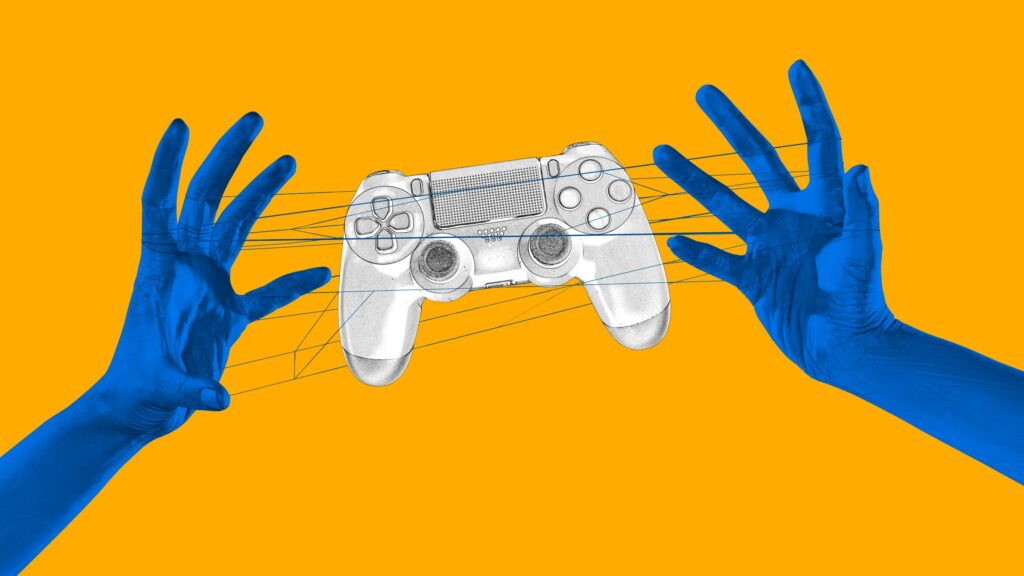The gaming market has witnessed tremendous growth over the years. It has surpassed music and movies combined. Today, it is popular in every corner of the earth, with all demographic groups. Gamers are spending more time engaged in play and its social and community activities. There are uncharted limits on its growth (1).
Since the gaming industry is getting bigger every day, it has huge implications for entrepreneurs operating within the ecosystem, including content creators, developers, distributors, and gaming platforms.
Let’s consider a few numbers that will allow you to comprehend the overall picture of the ongoing expansion of the gaming industry (2).
- According to estimates, there are over 2.7 billion gamers worldwide in 2021.
- There are more than 405 million YouTube subscribers on the top ten gaming influencers.
- According to Accenture, the indirect and direct value of the gaming market is over 300 billion USD, which is much higher than the industry’s previous estimates.
Gaming Industry is Biggers Than Music and Movies Market Combined
The gaming industry, whose valuation is already bigger than music and movies combined, has witnessed a massive surge in its growth over the past few years. The momentum has accelerated more than ever as people spend more time at home amid the coronavirus pandemic.
According to Accenture (3), the full value of the gaming ecosystem is already more than 300 billion USD. That is from the 200 billion USD indirect spend on consoles, software subscriptions, mobile ad revenues, and in-game purchases. The other 100 billion USD value comes from adjacent industries like gaming PCs, smartphones, peripherals, and other gaming-related communities.
The Gamification Concept and Its Impact
There is also a significant impact of gaming on entertainment and culture across the globe, spanning from successful movie franchises to arena-based tournaments, toys, and more.
Even other industries such as defense, medical, corporate training, and education are using gaming-born innovations. Notably, one of the fastest-growing segments of the Roblox platform is K-12 education.
The gamification concept, widely applied in several industries, uses game design mainstays such as points, rankings, and badges to engage and educate users. Meanwhile, we are witnessing gaming platforms evolving into digital social platforms where players can communicate, watch live-streamed events, listen to music, hang out, make purchases, etc.
The Industry Drivers
The increased internet penetration and huge adoption of smartphones worldwide are bringing new players into the gaming ecosystem. And smartphones will continue to allow new opportunities to emerge with the gaming world, which never existed in the past.
However, instead of cannibalizing existing markets for console and PC gaming, the industry has now started emphasizing gaming’s social dimensions. And as it happens, we are witnessing new levels of engagement, groups turning to online competitors.
For instance, during the pandemic, we witnessed some of the world’s leading race car drivers competing online, top chess players adopting Discord. Industry leaders have started recognizing gaming as more than a product-centric market. It is now becoming a continuous service-oriented business, where customer experience comes first.
The gaming industry needs to find the balance between its newest adopters, the new 400 million new gamers expected to join in the upcoming few years, and the expectations of historical gaming loyalties, who are still the industry’s most lucrative consumers, to realize its full potential (4).
The Indian Gamers
According to Deloitte, India would add about 40 million online gamers between 2020 to 2022. Another report from Maple Capital Advisor indicates that the Indian gaming industry will grow 41% y-o-y because of the growth in the country’s digital infrastructure.
The report also claims that by 2024, the Indian gaming industry will be worth over 3,750 million USD, and considering these figures; we are at the cusp of a great Indian gaming boom (5).
According to Statista (6), India recorded about 365 million online gamers in FY 2020. It is estimated that these numbers would reach 510 million by FY 2022. Overall, India ranked the highest globally in online game downloads in the app stores, with a 165% growth rate between 2016 to 2018.
Number of Online Gamers in India (2018 to 2022)

Globally, there are 2.7 billion gamers.
According to Accenture, there are four largest gaming markers: China, the US, Japan, and the UK. When combined, these markets make 47% of all worldwide gamers and 64% of all direct consumer spend on gaming.
Fourteen other markets, including Germany, France, South Korea, Canada, Italy, and Spain, made more than 1 billion USD in consumer-related revenue.
Apart from India, the popularity of gaming is also surging in Latin America, Middle East, and other southeast Asian nations with a mobile-first approach.
Gaming Has a New Face
According to Accenture’s research (7), even though there is a wide mark of the stereotype that young men make up the majority of gamers, there are now nearly as many as female gamers, 46% as there are male, 52%. There are also 2% identifying as gender non-binary or opting not to answer, thanks to widespread smartphone adoption.
21% of gamers who have been playing only for about four years or less, the hundreds of millions of new gamers are driving the industry’s growth, especially in smartphones. As the gamers join the gaming community, they are also changing it. Their profiles are different across demographic characteristics like gender, age, and ethnicity from those legacy gamers.
New gamers today are younger on average, while 30% of new gamers are under 25, only 21% of legacy gamers fall within that age range. There is also a greater representation of females among new gamers; they account for 60% instead of 39% of experienced gamers. And one-third of new gamers are non-white, compared to only 24% of experienced gamers.
The World of Social Gaming
People are gaming across mobile phones, PCs, and consoles. While the popularity of different gaming genres varies by device, role-playing, a multiplayer online battle arena, first-person shooter, and battle royale-style gamers are the most popular.
According to Accenture, over half of gamers indicate they have played cross-platform gamers, with new gamers 60% more likely to have done so than experienced, 50%.
However, like what they are playing and the devices they are using, who they are playing with is also significant. The social side of the gaming ecosystem is big and growing. As per Accenture research, 84% of people said that video games helped them connect with people with similar interests. They are also getting to meet new people. It has become even more important during the pandemic, with three-quarters of gamers saying that most of their social interactions now happen on one gaming platform or another.
Take a look at Discord’s massive growth during the pandemic as a platform for both gaming and social interaction (8, 9). In short, video games have played an important role in helping gamers stay in touch with their friends.
Some gamers spend about 16 hours a week playing gamers, eight hours a week watching or joining game streams, and six hours a week interacting in gaming communities and forums. For several gamers, it is not an escape from the real world; for them, the immersive world of gaming is just as real. And it indicates that the distinctions between playing a game and social interaction are getting blurred if not disappearing completely (10).
A Shift From Product to Service
With the gaming industry’s explosive growth, there is also a surge in customers’ demand for social interactions. Businesses in the segment need to increase their focus on the user experience. Gaming is no longer a product industry; it is now transformed into a service industry as cross-platform and social interactions become increasingly pervasive.
As the social and online aspect of gaming increasingly defines the whole experience, the industry needs to speed the move from a focus on content and franchise to see itself in the business of offering a continuous end-to-end service with positive consumer experiences.
However, with several new and diverse gamers joining in, businesses face some challenges when creating an immersive experience that’s enjoyed by all.
The Challenges
Inappropriate Behaviour
Competitive gameplay is one of the primary reasons gaming is appealing to numerous people. And considering the competitive nature of several multiplayer games, it is no surprise that combative behavior is part of the experience for many.
In the online gaming world, competitive games have been an unconstrained area for a long time with few limits on expression. While many gamers see gaming as a safe outlet for saying what they want, not everyone is comfortable.
For instance, some gamers have experienced threats like aggressive or toxic chat, gender-based bullying like sexist comments (11), and hate speech like homophobia, racism, and transphobia. It is a highly complex area for gaming businesses to navigate, especially when some gamers consider “trash talk” a standard gaming element (12).
One of the major challenges for gaming businesses is that players who exhibit negative behavior are often also the biggest spenders. And it raised an important question for the industry: how to offer a positive gaming environment to all players?
Real-World Consequences
Gamers’ perceptions of these issues will always vary, sometimes to an extreme degree. However, we can’t dismiss that many players are not happy with the current state of play.
According to Accenture’s research, gamers increasingly want businesses to take action and do more to prevent unacceptable behavior. Many would welcome more active moderation, 70%.
Gamers also suggest suspension or even outright bans for extreme cases of players for inappropriate conduct via censoring explicit material within in-game chats, recording, and analyzing in-game voice communications. Gaming companies should actively promote anti-bullying to their consumers, says 54% of gamers.
It is where the industry is going. Take Roblox, for instance, a gaming platform built around the younger population that prioritizes teaching empathy, kindness, and teamwork skills to its communities. Moderators on the platform can create a safe experience for users using AI, machine learning, and chat filtering.
“Safety has always been our priority. My role is to focus on building healthy communities, positive experiences, and educating the community to go then and be good people elsewhere online,” says Laura Higgins, Roblox’s director of community safety and digital civility (13).
Overall, the gaming industry needs to come together to share best practices and tools to promote digital civility.
According to Dr. Kimberly Voll, Fair Play Alliance’s co-founder (14), “when we analyze the root causes of why these behaviors emerge, when we realize that there is a possibility of mismatched expectations or friction, we as game developers need to invest in lowering the chances of that happening at the initial stages before a game gets off on the wrong foot and users start taking shots at each other.”
There are new tech-based approaches launched all the time. One recent approach came from the GIX, Global Innovation Exchange of the University of Washington (15). The GIX team build a Temper, a software, hardware, and cloud device that notifies gamers of potentially toxic behavior and stops a game if the behavior is repeated.
And the good news for developers is that gamers will reward positive steps they will take by engaging and playing more. As per Accenture, 70% of gamers are more likely to play a game if moderated to eliminate bullying and toxicity. Gamers, 68%, are more likely to play more if the game offers easy methods to report bullying and toxicity (16).
On the other hand, if developers allow bad actors to keep unchecked, it can have consequences on the platforms as we see on social media platforms. It can be in the form of great scrutiny from outside the industry or gamers who have had enough and decide to take their money elsewhere.
If such concerns remain unaddressed, continued negative experiences can diminish gamers’ gaming enthusiasm. About 37% of women and 32% of men have quit a video game because of bullying, and more than 50% of gamers know someone else who has left (17).
Notably, words also get around. Four of ten gamers stated that they had talked negatively about a game because of how the company handled bullying concerns.
The Gaming Ecosystem is Evolving
There is a decisive shift that is changing the face of gaming as new gamers bring new expectations about social interactions and experiences. And their expectations may differ from legacy players. While it can create friction, it can also create an opportunity for businesses to make a difference in end-to-end experiences.
According to Accenture, businesses need to balance the needs of the new gamers with legacy players to realize the industry’s full potential and build a number of long-term paying gamers.
It is essential as the behaviors of a few can impact the many, as found by other social media platforms. And as the online gaming communities are getting bigger, there is a greater chance of amplifying any negative experiences.
Like all successful online services, businesses in the gaming industry need to differentiate themselves via their customer experience quality. Any negative experiences can lead to severe economic impacts for providers and creators.
The Experience is Necessary
As noted, gaming experiences are becoming more similar to those on social media platforms, where attracting and retaining consumers are key success drivers. Fostering a more inclusive and healthier gaming space is the right thing to do, and it can also be a clear differentiator.
Businesses need to work in this area to offer better experience actively. Of course, it is a challenge since it is a dynamic market with players playing across different platforms, often concurrently. And, several of these gamers are paying customers, unlike social platforms.
It would be useful for the gaming industry to learn from the experiences of social media platforms. There is an opportunity to take advantage of approaches and solutions across AI, enhanced transparency, moderation, and increased industry-wide collaboration. Some leading gaming developers are creating a great example. For instance, RIOT is teaming up with hundreds of other entities within the industry (18) to join the Fair Play Alliance, a worldwide coalition of gaming companies looking to bring more inclusive experiences to players.
Final Words
Today, the gaming industry is no longer a hit-driven market. Businesses need to find their most valuable gamers and communities and understand why they are here. Once gaming companies understand what their gamers enjoy, they can double down on those things instead of focusing on why other players are not staying. That way, more players will start coming.
The industry is turning into a co-op where people play together not only because the game is fun but also because they are playing it with their friends and the community they enjoy.











![Read more about the article [Techie Tuesday] From building systems at VMWare to creating a B2B edtech platform for colleges, meet Coll Poll’s Sabari Girish Parampoor](https://blog.digitalsevaa.com/wp-content/uploads/2022/04/ImageTaggingPooja3-1650294236838-300x150.jpg)